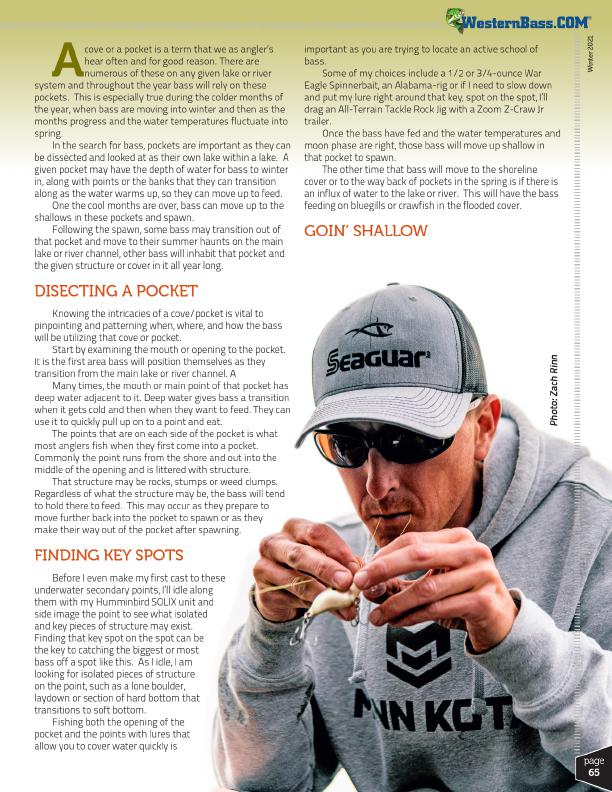
®
A
cove or a pocket is a term that we as angler’s
hear often and for good reason. There are
numerous of these on any given lake or river system and throughout the year bass will rely on these
pockets. This is especially true during the colder months of
the year, when bass are moving into winter and then as the
months progress and the water temperatures fluctuate into
spring.
In the search for bass, pockets are important as they can
be dissected and looked at as their own lake within a lake. A
given pocket may have the depth of water for bass to winter
in, along with points or the banks that they can transition
along as the water warms up, so they can move up to feed.
One the cool months are over, bass can move up to the
shallows in these pockets and spawn.
Following the spawn, some bass may transition out of
that pocket and move to their summer haunts on the main
lake or river channel, other bass will inhabit that pocket and
the given structure or cover in it all year long.
important as you are trying to locate an active school of bass.
Some of my choices include a 1/2 or 3/4-ounce War Eagle Spinnerbait, an Alabama-rig or if I need to slow down and put my lure right around that key, spot on the spot, I’ll drag an All-Terrain Tackle Rock Jig with a Zoom Z-Craw Jr trailer.
Once the bass have fed and the water temperatures and moon phase are right, those bass will move up shallow in that pocket to spawn.
The other time that bass will move to the shoreline cover or to the way back of pockets in the spring is if there is an influx of water to the lake or river. This will have the bass feeding on bluegills or crawfish in the flooded cover.
GOIN’ SHALLOW
Photo: Zach Rinn
DISECTING A POCKET
Knowing the intricacies of a cove/pocket is vital to pinpointing and patterning when, where, and how the bass will be utilizing that cove or pocket.
Start by examining the mouth or opening to the pocket. It is the first area bass will position themselves as they transition from the main lake or river channel. A
Many times, the mouth or main point of that pocket has deep water adjacent to it. Deep water gives bass a transition when it gets cold and then when they want to feed. They can use it to quickly pull up on to a point and eat.
The points that are on each side of the pocket is what most anglers fish when they first come into a pocket. Commonly the point runs from the shore and out into the middle of the opening and is littered with structure.
That structure may be rocks, stumps or weed clumps. Regardless of what the structure may be, the bass will tend to hold there to feed. This may occur as they prepare to move further back into the pocket to spawn or as they make their way out of the pocket after spawning.
FINDING KEY SPOTS
Before I even make my first cast to these underwater secondary points, I’ll idle along them with my Humminbird SOLIX unit and side image the point to see what isolated and key pieces of structure may exist. Finding that key spot on the spot can be the key to catching the biggest or most bass off a spot like this. As I idle, I am looking for isolated pieces of structure on the point, such as a lone boulder, laydown or section of hard bottom that transitions to soft bottom.
Fishing both the opening of the pocket and the points with lures that allow you to cover water quickly is
Winter 2021
page 65